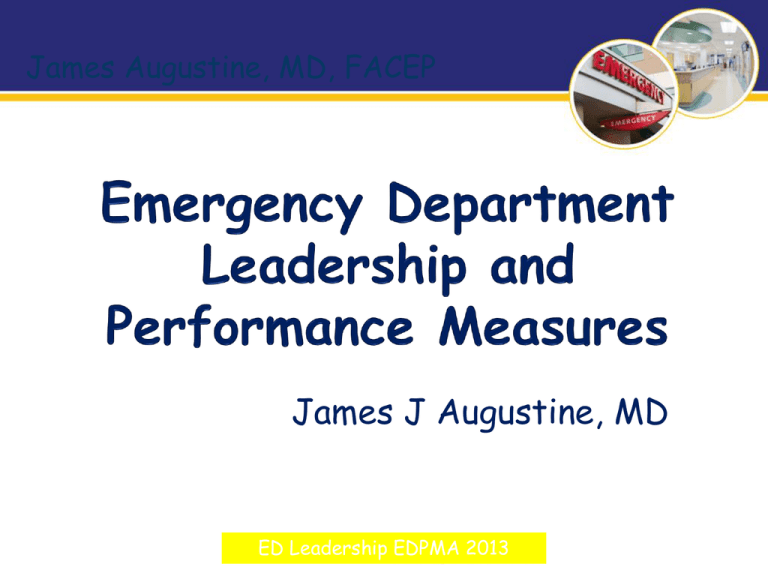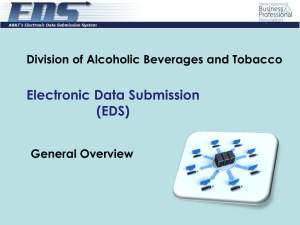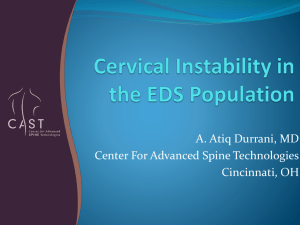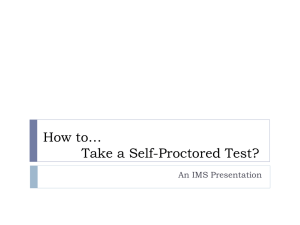EDs - 2015 EDPMA Solutions Summit
advertisement

James Augustine, MD, FACEP James J Augustine, MD ED Leadership EDPMA 2013 James J Augustine, MD I have no financial relationships with a commercial entity producing healthcare-related products and/or services. Course Name ED Leadership EDPMA 2013 The ED Volume Issue for ED Leaders. Even if You Don’t Build it They Will Come!!! ED Leadership EDPMA 2013 The CDC Data: Americans Vote With Their Feet ED Visits 160,000,000 140 Million ED Visits 140,000,000 120,000,000 100,000,000 80,000,000 ED Visits 60,000,000 40,000,000 20,000,000 1992 1995 1997 2000 2001 2002 2003 2004 2005 2006 2007 2008 2009 2010 2011 2012 2013 2014 0 ED Leadership EDPMA 2013 The CDC: NHAMCS 2007 Last Published ED Leadership EDPMA 2013 The Regulatory Issue. They Want Measures of Quality. If they don’t exist… • CMS on ED Quality: Pneumonia Measures, … • CMS on Admission Times • Current Definition –Admit Decision to Departure Time –Time Interval beginning when “Admit Decision” is made until the actual departure time of the patient from the ED This is a CMS Hospital Inpatient Quality Measure for public reporting in 2013 ED Leadership EDPMA 2013 New Directions/Data Elements • Shall we collect and share some CMS metrics? • The “Decision to Admit” debate – CMS definition= admit order from the chart – More helpful might be “I know I want to admit the patient”, documented on the chart • A new metric we can develop within EDBA? • How about a new or at least consistent RN staffing metric? – RN work varies not by arrivals but by severity and how many patients are in the department (LOS and admit percent proxy) ED Leadership EDPMA 2013 7 ED Performance Measures –Early Problem: There are no consistent definitions in industry –EDBA hosted Summit 2006 –Second summit in 2010 in SLC Published 2011 in Annals and AEM –AHRQ funded program on improved ED intake systems ED Leadership EDPMA 2013 NHAMCS Update Just Published for 2010 Volume down from 2009 (H1N1 year) Acuity Up Demographic trends continue: more elderly, more medical ED Leadership EDPMA 2013 EDBA Solutions Utilize and assist the CDC NHAMCS survey Produce good data source for ED leaders Don’t put ACEP and ENA in untenable positions Find places to disseminate and publish Call together groups and produce Definitions (ED Performance Measures Summit in 2006) Counteract “Street Legends” Identify Best Practices ED Leadership EDPMA 2013 Financing the ED: MEPS Data • Medical Expenditure Panel Survey (MEPS), a publicly available dataset available through the Agency for Healthcare Research and Quality (AHRQ). MEPS is an ongoing nationally representative survey which provides data on health care use and expenditures. MEPS is a large-scale survey of the U.S. non-institutionalized civilian population which uses a stratified, multistage probability sampling design • http://meps.ahrq.gov/mepsweb/ • • • • • For Years 2005 to 2010 Medicaid Uninsured Private Medicare Total Charges $2122.9 Total Payments $553.2 Total Charges $2040 Total Payments $550 Total Charges $2178.2 Total Payments $991.1 Total Charges $2500 Total Payments $1000 ED Leadership EDPMA 2013 Florida Data • • • • Published by FL Agency for Health Care Administration Average charges per hospital ER visit (2008 prices) – $2996 for adult – $1324 for child Non-emergent ER visits • $2907 adult • $1278 pediatric Based on common symptoms – $5135 for abdominal pain visit – $2655 average cost for hypertension – $1878 for asthma – $2000 - $3000 for headache including migraine ED Leadership EDPMA 2013 Florida Data • • • • • • • • About half of all Florida ER visits were deemed avoidable An interactive model is available Count 7.1 m visits to June 2012 $3562 average charge for facility, physician, and ancillary services Results in $25.6 B in charges If that is same across country: 140m visits results in $498,689,000,000 charges A 30% collection rate equals $149.604 Billion ED Leadership EDPMA 2013 An Early Observation: ED Process Depends on ED Volume The 2010 Challenge The 1990 Challenge ED Leadership EDPMA 2013 The EDBA Annual Data Survey 2011 Results for 830 EDs seeing 29.6m pts Over 100K EDs 2011 results 80 to 100K EDs 2011 results 60 to 80K EDs 2011 results 40 to 60K EDs 2011 results 20 to 40K EDs 2011 results Under 20K EDs 2011 results Hi CPT Acuity Under age 18 Admit % Transfer % EMS Arrival EMS Arrival Admit Median LOS 66% 20.2% 21.8% 0.9% 23% 42% 214 182 71% 18.4% 20.9% 1.1% 21% 44% 218 66% 18.2% 20.8% 1.2% 19% 44% 65% 19.5% 19.1% 1.4% 18% 63% 20.2% 17.1% 1.8% 55% 23.7% 12.7% 99.0% 2.7% Pediatric EDs 48% 2011 Results Adult, Specialty EDs 71% 2011 Results Urgent Care, Freestanding EDs 41% 23.6% 2011 Results LBTC Door to Doc EKG per 100 356 2.3% 31 30 187 362 3.4% 38 25 205 174 337 2.8% 35 31 43% 186 156 303 2.3% 33 28 16% 41% 160 134 261 1.7% 28 26 2.7% 12% 39% 139 115 227 1.4% 23 20 11.4% 0.6% 8% 33% 147 132 270 1.4% 31 4 25.5% 1.1% 23% 48% 240 204 346 3.2% 40 34 4.2% 3.4% 7% 31% 100 97 240 1.0% 22 12 ED Leadership EDPMA 2013 MLOS Treat MLOS & Release Admit Percentage admitted 40% 95% CI Notched Outlier Boxplot 35% Outliers > 1.5 and < 3 IQR 30% Outliers > 3 IQR 25% 20% 15% 10% 5% 0% Admit % ALL EDs 4/8/2015 Admit % >100K Admit % 80-100K Admit % 60-80K Admit % 40-60K Admit % Admit % 1- Admit % 20-40K 20K AdultEDs Admit % PedEDs 16 ED Leadership EDPMA 2013 % Leaving Before Treatment is Complete (LBTC) 8% 95% CI Notched Outlier Boxplot 7% Outliers > 1.5 and < 3 IQR 6% Outliers > 3 IQR 5% 4% 3% 2% 1% 0% LBTC ALL EDs 4/8/2015 LBTC >100K LBTC 80100K LBTC 6080K LBTC 4060K LBTC 2040K LBTC 120K LBTC AdultEDs LBTC PedEDs 17 ED Leadership EDPMA 2013 Patient Flow is Predictable General Population EMS Emergency Department Walk-ins to ED 371 / 1000 Population 80/1000 Total use 451 / 1000 Population Population 82% Walk-Ins 18% Arrival by EMS Transfer Admit 2% 17% Treat & Release 81% ED Leadership EDPMA 2013 LBTC 2% Trending and Planning: NHAMCS Helps Predict Future Patient Flows 3% more patients per year for about the last 18 years Injury is 34% of ED Patient Load Highest injury rates are over age 75 Extended Care Facility Patients are the Most Frequent ED User 3 m visits in 2010 45% admission rate ED Leadership EDPMA 2013 Predicting Volume Ahead Graying of the ED 800 700 600 500 1992 400 2008 300 200 100 0 All ED Visits Ages 45 - 64 ED Leadership EDPMA 2013 Age over 65 Age over 75 Not Only More ED Visits in the Senior Age Brackets More Population Enters those Age Groups Each Year 800 Graying of the ED 700 600 500 1992 400 2008 300 200 100 0 All ED Visits Ages 45 - 64 ED Leadership EDPMA 2013 Age over 65 Age over 75 The Patient Mix. Very Important and Unrecognized Issue The Burn, Trauma, Injury and Cardiac Arrest Issue What should we have known? Prevention Works When prevention works, more people are alive to get ill Trauma population ages ED Leadership EDPMA 2013 Changing ED Patient Mix ED Leadership EDPMA 2013 The ED Payer Mix not Changing Much, except Medicare Payor Class % of Visits Self Pay 15% Medicare 18% Medicaid 31% Worker’s Comp. 1.2% Commercial 37% ED Leadership EDPMA 2013 ED Utilization Use Per 1000 Persons • • • • • • • Nursing Home Residents (over 1000) Homeless (around 1000) Infants under age 1 (931) Medicaid Medicare Insured Self Pay ED Leadership EDPMA 2013 Adult & Pediatric EDs Serve Different Needs ED Leadership EDPMA 2013 ED Visits 1992 to 2010 Diagnostics ED Leadership EDPMA 2013 ED Visits 1992 to 2010 Therapeutics ED Leadership EDPMA 2013 ED Visits 1992 to 2010 Critical Care ED Leadership EDPMA 2013 ED Visits 1992 to 2010 Mental Health ED Leadership EDPMA 2013 The EDBA Data Survey Super Centers Over 100K Over 275 PPD Very Large Over 80,000 Over 220 PPD Large 60 – 80K 165 – 220 Medium 40 – 60K 110 – 165 Small 20 – 40K 55- 110 Micro Under 20K Under 55 Pediatric and Freestanding EDs Any Volume Any PPD ED Leadership EDPMA 2013 EDBA Survey 2012 1000+ EDs serving over 33 million patients Volume was up 4-6% versus 2011 Patient acuity higher, and more patients admitted Continued increase in EKG utilization Xray use is down, plateau in use of CT MRI now running about 1% ED Leadership EDPMA 2013 EDBA Survey 2012 EDs are improving throughput, walkaway rates have decreased About 18% arriving by ambulance and are admitted at an increasing rate Payor mix stable, except more MCR Bed Utilization around 1600 visits per patient care space CPOE about 75% New Team Triage systems over 25% ED Leadership EDPMA 2013 The EDBA Annual Data Survey LBTC Door to Doc EKG per 100 356 2.3% 31 30 187 362 3.4% 38 25 205 174 337 2.8% 35 31 43% 186 156 303 2.3% 33 28 16% 41% 160 134 261 1.7% 28 26 2.7% 12% 39% 139 115 227 1.4% 23 20 11.4% 0.6% 8% 33% 147 132 270 1.4% 31 4 2.7% 25.5% 1.1% 23% 48% 240 204 346 3.2% 40 34 Urgent Care, Freestanding EDs 41% 23.6% 2011 Results 4.2% 3.4% 7% 31% 100 97 240 1.0% 22 12 2011 Results for 830 EDs seeing 29.6m pts Over 100K EDs Super Centers 2011 results 80 to 100K EDs 2011 results 60 to 80K EDs 2011 results 40 to 60K EDs 2011 results 20 to 40K EDs 2011 results Under 20K EDs 2011 results Hi CPT Acuity Under age 18 Admit % Transfer % EMS Arrival EMS Arrival Admit Median LOS 66% 20.2% 21.8% 0.9% 23% 42% 214 182 71% 18.4% 20.9% 1.1% 21% 44% 218 66% 18.2% 20.8% 1.2% 19% 44% 65% 19.5% 19.1% 1.4% 18% 63% 20.2% 17.1% 1.8% 55% 23.7% 12.7% 99.0% Pediatric EDs 48% 2011 Results Adult, Specialty EDs 71% 2011 Results ED Leadership EDPMA 2013 MLOS Treat MLOS & Release Admit Location and Type Urban Suburban Rural Academic Trauma Over 100K 56% 44% 0 78% 94% 80 to 100K 72% 24% 4% 68% 85% 60 to 80K 48% 49% 3% 42% 66% 40 to 60K 50% 39% 11% 30% 42% 20 to 40K 42% 29% 29% 19% 25% Under 20K 24% 27% 49% 5% 3% Adult ED 95% 5% 0 67% 61% Peds ED 83% 17% 0 67% 63% ED Leadership EDPMA 2013 Functional Areas in the ED Fast Track Trauma Area CDU/Obs CPOE Over 100K 88% 88% 50% 87% 80 to 100K 90% 80% 24% 80% 60 to 80K 60% 59% 35% 83% 40 to 60K 61% 24% 19% 65% 20 to 40K 48% 18% 7% 70% Under 20K 2% 0 2% 75% Adult ED 75% 69% 8% 80% Peds ED 70% 50% 8% 90% 33% 18% ED Leadership EDPMA 2013 75% All EDs 58% Documentation Computerized Dictated Templates Hand Written Scribes Over 100K 50% 21% 28% 21% 21% 80 to 100K 75% 10% 15% 10% 25% 60 to 80K 60% 45% 24% 17% 19% 40 to 60K 61% 27% 21% 17% 17% 20 to 40K 67% 24% 14% 11% 15% Under 20K 70% 17% 22% 10% 10% Adult ED 63% 23% 25% 12% 25% Peds ED 54% 8% 4% 8% 4% 67% 23% 20% 12% 16% All EDs ED Leadership EDPMA 2013 Greeting Process Nursing Physician MLP Over 100K 100% 17% 6% 80 to 100K 100% 40% 5% 60 to 80K 100% 19% 17% 40 to 60K 100% 31% 10% 20 to 40K 100% 6% 5% Under 20K 92% 0 2% Adult ED 100% 21% 12% Peds ED 100% 3% 0% 98% 18% 8% All EDs ED Leadership EDPMA 2013 Scheduled Hours NOT worked hours RN Techs and Clerks Physician Physician and MLP Over 100K 0.7 1.1 2.65 2.2 80 to 100K 0.7 1.3 2.87 2.3 60 to 80K 0.7 1.5 2.65 2.3 40 to 60K 0.6 1.4 2.89 2.7 20 to 40K 0.7 1.9 2.63 2.1 Under 20K 0.6 1.5 1.7 1.5 Adult ED 0.6 1.4 2.52 2.0 Peds ED 0.6 1.5 2.12 1.9 0.7 1.5 2.5 2.2 All EDs ED Leadership EDPMA 2013 High Acuity ED Visits ED Leadership EDPMA 2013 Length of Stay and Walkaway ED Leadership EDPMA 2013 Length of Stay and LBTC ED Leadership EDPMA 2013 Admit Times (CMS Measure) ED Leadership EDPMA 2013 EMS Impact: 26M Transports 42% admitted Most Common Presentations: Chest pain and heart disease Short of breath Contusions/blunt injury Sprains of neck and back (MVA) Syncope and seizures ED Leadership EDPMA 2013 Correlation of EMS Arrival and Admission 25% 20% 15% Admits EMS 10% 5% 0% Very Large Large Medium Small ED Leadership EDPMA 2013 Micro PEDs &Freestanding Eds Important Trends even over only 8 years of Data Year 2011 EKG Hospital Admits 26 67% 2010 24 67% 2009 23 65% 2008 22 64% 2007 20 62% 2006 19 61% 2005 18 61% 2004 17 58% ED Leadership EDPMA 2013 EKG Utilization Increases from 2004 to 2011 35 30 25 20 15 10 5 0 Macro Very Large Large Medium Small Micro ED Leadership EDPMA 2013 PED EDs Adult EDs Admissions Through ED Percentage 70% 60% 50% 40% 30% 20% 10% 0% 1980 ED Leadership EDPMA 2013 1990 2010 ED Geography: Space and Bed Utilization Size of Facility Square Footage Per Bed Super Center 3.9 1422 Very Large 3.2 1606 Large 2.8 1561 Medium 3.3 1621 Small 3.2 1641 Micro 2.6 1391 Pediatric EDs 3.7 1792 Adult EDs 3.3 1389 ED Leadership EDPMA 2013 Making the Data Valuable: A Day in our ED 130 Patients to be seen, although 3 want to leave 40 Will be in Fast Track 56 Will need Monitors 23 Will be Admitted 26% Of Patients in Main ED 6 Will have Dental Problem 991 25 Orders will be Entered in CPOE, or 7.6 per patient, and 21% of all orders Entered in the Hospital Today Will Arrive by EMS ED Leadership EDPMA 2013 ED Metrics and ED Future Plan Forward with Hard Numbers Know, Understand, and Share your Numbers, Compare to Cohorts Make Sure all Staff Know Numbers Use Data to Drive Future Tell Your Story Effectively in Developing Designs, Process, Staff ED Leadership EDPMA 2013





